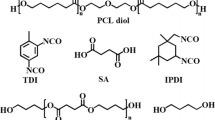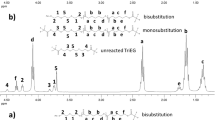Abstract
A series of non-isocyanate linear high molecular weight poly(ester urethane)s (PETUs) were prepared through an environmentally-friendly route based on dimethyl carbonate, 1,6-hexanediol and 1,6-hexanediamine. In this route, the polyurethane diol was first prepared by the reaction between bis-1,6-hexamethylencarbamate (BHC) and 1,6-hexanediol. A series of polyester soft segments of polyurethane have been synthesized from the polycondensation of adipic acid and different diols, including butanediol, hexanediol, octanediol and decanediol. The subsequent polycondensation of polyurethane diol and polyester diol led to linear PETUs. The resultant polymers were characterized by GPC, FTIR, 1H-NMR, 13C-NMR, DSC, WAXD, TGA and tensile test. The results indicated that PETUs possess weight-average molecular weights higher than 1×105 and the tensile strength as high as 10 MPa. The thermal properties, crystallization behavior, microphase separation behavior and morphology were studied by DSC and AFM, and the results indicated that the degree of phase separation was affected by two factors, the crystallization and hydrogen bonding interaction between soft segment and hard segment.
Similar content being viewed by others
References
Pérez-Sena, W. Y.; Cai, X.; Kebir, N.; Vernières-Hassimi, L.; Serra, C.; Salmi, T.; Leveneur, S. Aminolysis of cyclic-carbonate vegetable oils as a non-isocyanate route for the synthesis of polyurethane: a kinetic and thermal study. Chem. Eng. J. 2018, 346, 271–280.
Wu, P.; Cheng, H.; Wang, X.; Shi, R.; Zhang, C.; Arai, M.; Zhao, F. A self-healing and recyclable polyurethane-urea Diels-Alder adduct synthesized from carbon dioxide and furfuryl amine. Green Chem. 2021, 23, 552–560.
Dechent, S. E.; Kleij, A. W.; Luinstra, G. A. Fully bio-derived CO2 polymers for non-isocyanate based polyurethane synthesis. Green Chem. 2020, 22, 969–978.
Ma, S.; Liu, C.; Sablong, R. J.; Noordover, B. A.; Hensen, E. J.; van Benthem, R. A.; Koning, C. E. Catalysts for isocyanate-free polyurea synthesis: mechanism and application. ACS Catal. 2016, 6, 6883–6891.
Pronoitis, C.; Hakkarainen, M.; Odelius, K. Solubility-governed architectural design of polyhydroxyurethane-graft-poly(ε-caprolactone) copolymers. Polym. Chem. 2021, 12, 196–208.
Ghasemlou, M.; Daver, F.; Ivanova, E. P.; Murdoch, B. J.; Adhikari, B. Use of synergistic interactions to fabricate transparent and mechanically robust nanohybrids based on starch, non-isocyanate polyurethanes, and cellulose nanocrystals. ACS Appl. Mater. Interfaces 2020, 12, 47865–47878.
Chen, H.; Chauhan, P.; Yan, N. “Barking” up the right tree: biorefinery from waste stream to cyclic carbonate with immobilization of CO2 for non-isocyanate polyurethanes. Green Chem. 2020, 22, 6874–6888.
Tremblay-Parrado, K. K.; Bordin, C.; Nicholls, S.; Heinrich, B.; Donnio, B.; Avérous, L. Renewable and responsive cross-linked systems based on polyurethane backbones from clickable biobased bismaleimide architecture. Macromolecules 2020, 53, 5869–5880.
Monie, F.; Grignard, B.; Thomassin, J. M.; Mereau, R.; Tassaing, T.; Jerome, C.; Detrembleur, C. Chemo- and regioselective additions of nucleophiles to cyclic carbonates for the preparation of self-blowing non-isocyanate polyurethane foams. Angew. Chem. Int. Ed. 2020, 132, 17181–17189.
Wulf, C.; Reckers, M.; Perechodjuk, A.; Werner, T. Catalytic systems for the synthesis of biscarbonates and their impact on the sequential preparation of non-isocyanate polyurethanes. ACS Sustain. Chem. Eng. 2020, 8, 1651–1658.
Leitsch, E. K.; Beniah, G.; Liu, K.; Lan, T.; Heath, W. H.; Scheidt, K. A.; Torkelson, J. M. Nonisocyanate thermoplastic polyhydroxyurethane elastomers via cyclic carbonate aminolysis: critical role of hydroxyl groups in controlling nanophase separation. ACS Macro Lett. 2016, 5, 424–429.
Beniah, G.; Liu, K.; Heath, W. H.; Miller, M. D.; Scheidt, K. A.; Torkelson, J. M. Novel thermoplastic polyhydroxyurethane elastomers as effective damping materials over broad temperature ranges. Eur. Polym. J. 2016, 84, 770–783.
Karami, Z.; Kabiri, K.; Zohuriaan-Mehr, M. J. Non-isoyanaate polyurethane thermoset based on a bio-resourced star-shaped epoxy macromonomer in comparison with a cyclocarbonate fossil-based epoxy resin: a preliminary study on thermo-mechanical and antibacterial properties. J. CO2 Util 2019, 34, 558–567.
Beniah, G.; Fortman, D. J.; Heath, W. H.; Dichtel, W. R.; Torkelson, J. M. Non-isocyanate polyurethane thermoplastic elastomer: amide-based chain extender yields enhanced nanophase separation and properties in polyhydroxyurethane. Macromolecules. 2017, 50, 4425–4434.
Ke, J.; Li, X.; Jiang, S.; Liang, C.; Wang, J.; Kang, M.; Li, Q.; Zhao, Y. Promising approaches to improve the performances of hybrid non-isocyanate polyurethane. Polym. Int. 2019, 68, 651–660.
Zareanshahraki, F.; Asemani, H.; Skuza, J.; Mannari, V. Synthesis of non-isocyanate polyurethanes and their application in radiation-curable aerospace coatings. Prog. Org. Coat. 2020, 138, 105394.
Boisaubert, P.; Kébir, N.; Schuller, A. S.; Burel, F. Photo-crosslinked non-isocyanate polyurethane acrylate (NIPUA) coatings through a transurethane polycondensation approach. Polymer 2020, 206, 122855.
Boisaubert, P.; Kébir, N.; Schuller, A. S.; Burel, F. Photo-crosslinked coatings from an acrylate terminated non-isocyanate polyurethane (NIPU) and reactive diluent. Eur. Polym. J. 2020, 138, 109961.
Panchireddy, S.; Grignard, B.; Thomassin, J. M.; Jerome, C.; Detrembleur, C. Catechol containing polyhydroxyurethanes as high-performance coatings and adhesives. ACS Sustain. Chem. Eng. 2018, 6, 14936–14944.
Grignard, B.; Thomassin, J. -M.; Gennen, S.; Poussard, L.; Bonnaud, L.; Raquez, J. M.; Dubois, P.; Tran, M. P.; Park, C. B.; Jerome, C. CO2-blown microcellular non-isocyanate polyurethane (NIPU) foams: from bio-and CO2-sourced monomers to potentially thermal insulating materials. Green Chem. 2016, 18, 2206–2215.
Wang, Z.; Zhang, X.; Zhang, L.; Tan, T.; Fong, H. Nonisocyanate biobased poly(ester urethanes) with tunable properties synthesized via an environment-friendly route. ACS Sustain. Chem. Eng. 2016, 4, 2762–2770.
Shen, Z.; Zhang, J.; Zhu, W.; Zheng, L.; Li, C.; Xiao, Y.; Liu, J.; Wu, S.; Zhang, B. A solvent-free route to non-isocyanate poly(carbonate urethane) with high molecular weight and competitive mechanical properties. Eur. Polym. J. 2018, 107, 258–266.
Ghasemlou, M.; Daver, F.; Ivanova, E. P.; Adhikari, B. Synthesis of green hybrid materials using starch and non-isocyanate polyurethanes. Carbohyd. Polym. 2020, 229, 115535.
Martin, A.; Lecamp, L.; Labib, H.; Aloui, F.; Kébir, N.; Burel, F. Synthesis and properties of allyl terminated renewable non-isocyanate polyurethanes (NIPUs) and polyureas (NIPUreas) and study of their photo-crosslinking. Eur. Polym. J. 2016, 84, 828–836.
Bossion, A.; Jones, G. O.; Taton, D.; Mecerreyes, D.; Hedrick, J. L.; Ong, Z. Y.; Yang, Y. Y.; Sardon, H. Non-isocyanate polyurethane soft nanoparticles obtained by surfactant-assisted interfacial polymerization. Langmuir 2017, 33, 1959–1968.
Kébir, N.; Nouigues, S.; Moranne, P.; Burel, F. Nonisocyanate thermoplastic polyurethane elastomers based on poly(ethylene glycol) prepared through the transurethanization approach. J. Appl. Polym. Sci. 2017, 134, 44991.
Li, S.; Sang, Z.; Zhao, J.; Zhang, Z.; Zhang, J.; Yang, W. Crystallizable and tough aliphatic thermoplastic polyureas synthesized through a nonisocyanate route. Ind. Eng. Chem. Res. 2016, 55, 1902–1911.
Suqing, L.; Jingbo, Z.; Zhiyuan, Z.; Junying, Z.; Wantai, Y. Influence of crystallizable units on the properties of aliphatic thermoplastic poly(ether urethane) s synthesized through a non-isocyanate route. J. Elastom. Plast. 2017, 49, 738–757.
Wang, G.; Yuan, X.; Zhao, J.; Zhang, Z.; Zhang, J.; Yang, W. Synthesis and properties of non-isocyanate thermoplastic polyurethanes containing dibutylene terephthalate units. J. Polym. Res. 2016, 23, 1–8.
Li, S.; Zhao, J.; Zhang, Z.; Zhang, J.; Yang, W. Synthesis and characterization of aliphatic thermoplastic poly(ether urethane) elastomers through a non-isocyanate route. Polymer 2015, 57, 164–172.
Li, S.; Zhao, J.; Zhang, Z.; Zhang, J.; Yang, W. Aliphatic thermoplastic polyurethane-ureas and polyureas synthesized through a non-isocyanate route. RSC Adv. 2015, 5, 6843–6852.
Deng, Y.; Li, S.; Zhao, J.; Zhang, Z.; Zhang, J.; Yang, W. Crystallizable and tough aliphatic thermoplastic poly(ether urethane) s synthesized through a non-isocyanate route. RSC Adv. 2014, 4, 43406–43414.
Yuan, X.; Sang, Z.; Zhao, J.; Zhang, Z.; Zhang, J.; Cheng, J. Synthesis and properties of non-isocyanate aliphatic thermoplastic polyurethane elastomers with polycaprolactone soft segments. J. Polym. Res. 2017, 24, 1–11.
Li, S.; Zhao, J.; Zhang, Z.; Zhang, J.; Yang, W. Synthesis and characterization of aliphatic segmented poly(ether amide urethane)s through a non-isocyanate route. RSC Adv. 2014, 4, 23720–23729.
Li, C.; Li, S.; Zhao, J.; Zhang, Z.; Zhang, J.; Yang, W. Synthesis and characterization of aliphatic poly(amide urethane)s having different nylon 6 segments through non-isocyanate route. J. Polym. Res. 2014, 21, 498.
Sun, D.; Xie S.; Deng J.; Huang C.; Ruckenstein E.; Chao Z. CH3COONa as an effective catalyst for methoxycarbonylation of 1,6-hexanediamine by dimethylcarbonate to dimethylhexane 1,6-dicarbamate. Green Chem. 2010, 12, 483–490.
Deng, Y.; Li, S. Q.; Zhao, J. B.; Zhang, Z. Y.; Zhang, J. Y.; Yang, W. T. Aliphatic thermoplastic poly(ether urethane)s having long PEG sequences synthesized through a non-isocyanate route. Chinese J. Polym. Sci. 2015, 33, 880–889.
Li, Y.; Li, S.; Zhao, J.; Zhang, Z.; Zhang, J.; Yang, W. Synthesis and characterization of crystallizable aliphatic thermoplastic poly(ester urethane) elastomers through a non-isocyanate route. Chinese J. Polym. Sci. 2016, 34, 1220–1233.
Wang, G.; Wang, Q.; Zhao, J.; Zhang, Z.; Zhang, J. Synthesis and thermal and mechanical properties of nonisocyanate poly(ether urethane) thermoplastic elastomers containing dibutylene terephthalate and poly(tetramethylene ether) segments. J. Elastom. Plast. 2021, 53, 191–209.
Li, S.; Deng, Y.; Zhao, J.; Zhang, Z.; Zhang, J.; Yang, W. Synthesis and properties of non-isocyanate crystallizable aliphatic thermoplastic polyurethanes. J. Wuhan Univ. Technol. 2018, 33, 1275–1280.
Deepa, P.; Jayakannan, M. Solvent-free and nonisocyanate melt transurethane reaction for aliphatic polyurethanes and mechanistic aspects. J. Polym. Sci., Part A: Polym. Chem. 2008, 46, 2445–2458.
Duval, C.; Kébir, N.; Charvet, A.; Martin, A.; Burel, F. Synthesis and properties of renewable nonisocyanate polyurethanes (NIPUs) from dimethylcarbonate. J. Polym. Sci., Part A: Polym. Chem. 2015, 53, 1351–1359.
Dongdong, P.; Hengshui, T. Polycarbonate polyurethane elastomers synthesized via a solvent-free and nonisocyanate melt transesterification process. J. Appl. Polym. Sci. 2015, 132, 41377.
Kébir, N.; Benoit, M.; Legrand, C.; Burel, F. Non-isocyanate thermoplastic polyureas (NIPUreas) through a methyl carbamate metathesis polymerization. Eur. Polym. J. 2017, 96, 87–96.
Shen, Z.; Zheng, L.; Li, C.; Liu, G.; Xiao, Y.; Wu, S.; Liu, J.; Zhang, B. A comparison of non-isocyanate and HDI-based poly(ether urethane): structure and properties. Polymer 2019, 175, 186–194.
Asadpour, S.; Yeganeh, H.; Ai, J.; Ghanbari, H. A novel polyurethane modified with biomacromolecules for small-diameter vascular graft applications. J. Mater. Sci. 2018, 53, 9913–9927.
Gostev, A. A.; Shundrina, I. K.; Pastukhov, V. I.; Shutov, A. V.; Chernonosova, V. S.; Karpenko, A. A.; Laktionov, P. P. In vivo stability of polyurethane-based electrospun vascular grafts in terms of chemistry and mechanics. Polymers 2020, 12, 845.
Han, L.; Dai, J.; Zhang, L.; Ma, S.; Deng, J.; Zhang, R.; Zhu, J. Diisocyanate free and melt polycondensation preparation of bio-based unsaturated poly(ester-urethane)s and their properties as UV curable coating materials. RSC Adv. 2014, 4, 49471–49477.
Gan, Z.; Abe, H.; Doi, Y. Biodegradable poly (ethylene succinate)(PES). 1. Crystal growth kinetics and morphology. Biomacromolecules 2000, 1, 704–712.
Gestí, S.; Almontassir, A.; Casas, M. T.; Puiggalí, J. Crystalline structure of poly(hexamethylene adipate). Study on the morphology and the enzymatic degradation of single crystals. Biomacromolecules 2006, 7, 799–808.
Kuwabara, K.; Gan, Z.; Nakamura, T.; Abe, H.; Doi, Y. Crystalline/amorphous phase structure and molecular mobility of biodegradable poly(butylene adipate-co-butylene terephthalate) and related polyesters. Biomacromolecules 2002, 3, 390–396.
Aneja, A.; Wilkes, G. L. A systematic series of ‘model’ PTMO based segmented polyurethanes reinvestigated using atomic force microscopy. Polymer 2003, 44, 7221–7228.
Acknowledgments
The authors acknowledge the National Natural Science Foundation of China (Nos. 52173009, 81971711, 21574137, 51373186), Beijing Natural Science Foundation (No. 2192065), and National Key R&D Program of China (No. 2016YFB1100800).
Author information
Authors and Affiliations
Corresponding authors
Additional information
Notes
The authors declare no competing financial interest.
Rights and permissions
About this article
Cite this article
Shen, ZY., Mei, QY., Liu, Y. et al. A Non-isocyanate Route to Poly(ester urethane) with High Molecular Weight: Synthesis and Effect of Chemical Structures of Polyester-diol. Chin J Polym Sci 40, 75–84 (2022). https://doi.org/10.1007/s10118-021-2645-5
Received:
Accepted:
Published:
Issue Date:
DOI: https://doi.org/10.1007/s10118-021-2645-5




